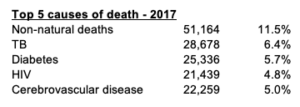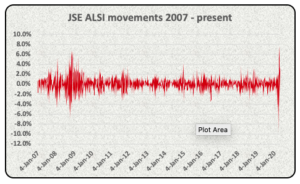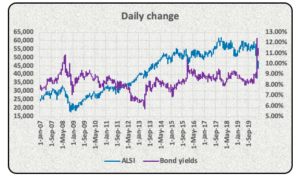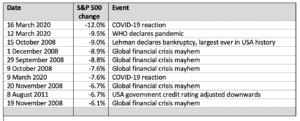Thanks to an article in the Financial Times this past weekend, I stumbled upon some research conducted by Daniel Kahneman and Alan Krueger published in 2006 in the Journal of Economics Perspectives. Kahneman received the Nobel Memorial Prize in Economics in 2002 for his decades of work in the field colloquially referred as ‘behavioral economics’. Anyway, Kahneman et al in the aforementioned study asked 909 working women in Texas about their emotional experiences during an average working day. The top 5 activities that provided the most positive effect for the respondents were intimate relations (I presume they meant sexual relations), socializing after work, relaxing, dinner and lunch. During the government imposed lockdown in South Africa I guess we could still enjoy four of those five activities, and also assuming that we and our partners are still communicating. The bottom five activities were morning commute, working, evening commute, childcare and housework. Oops, that’s trade off in the lockdown – no commuting but lot’s of childcare and housework for many.
Post the coronavirus, whenever that may be, our daily activities and patterns will definitely change. Personally, I foresee more online interactions (meetings, education and training and online purchases). I also look forward to tons of more exercise and outdoor activities. And perhaps a glass of chilled chardonnay if the government lifts this prohibition, which is treating its citizens as adolescents.
Moving from morbidity (the rate of disease in a population) to mortality, I did some research yesterday. According to Statistics South Africa (StatsSA), South Africa recorded 446,554 deaths in 2017 and the leading causes of death were:
 Non-natural deaths include those from traffic accidents, homicide, suicide and other fatal injuries. That’s astonishing, particularly compared to statistics in first world nations such as the USA. PS. 18,837 people passed away in 2017 in South Africa due to influenza and pneumonia.
Non-natural deaths include those from traffic accidents, homicide, suicide and other fatal injuries. That’s astonishing, particularly compared to statistics in first world nations such as the USA. PS. 18,837 people passed away in 2017 in South Africa due to influenza and pneumonia.
According to Dr. Bhattacharya, a professor of medicine at Stanford University with a Phd in economics, COVID-19 is highly infectious but is only likely to kill 1 or 2 persons per 1,000 of infected victims. Check out the youtube video of an interview of Dr. Bhattacharya posted on 17 April 2020 (https://youtube.be/k7v2F3usNVA), it provides fascinating insights into COVID-19. If I recall, it is a 42 minute video clip but hey, we are in lockdown and we may be running out of decent things to watch on Netflix and DSTV. In short, the takeouts from the interview with Dr. Bhattacharya include:
- The virus is more widespread than we think
- The mortality rate is unlikely to be anywhere near the WHO’s initial estimates of 3.4% and is more likely to be in the range of 0.1% to 0.2% of people who become infected, effectively meaning that this a bad strain of flu and people will die from it but not in numbers that is being bandied about in the press
- Eradication of the virus is unlikely until an effective vaccine is developed, probably years away
- It is unknown whether recovered victims can be re-infected, unlikely but not proven yet (which means the herd immunity argument falls flat until it is proven that we can develop immunity against COVID-19)
- Lockdowns are effective but only to allow healthcare facilities time to prepare to care for patients needing treatment.
So some good and some bad according to Dr. Bhattacharya. I think very encouraging actually.
Getting back to the morbid stats in South Africa. The causes of deaths amongst 15 to 44 year olds in South Africa in 2017 is highly distressing.
 The percentage of deaths in this age category due to non-natural causes is highly disturbing. Also, the number of people dying due to TB and HIV related causes is tragic.
The percentage of deaths in this age category due to non-natural causes is highly disturbing. Also, the number of people dying due to TB and HIV related causes is tragic.
Crossing the ocean to the USA, the number of deaths there in 2017 was 2.8 million people out of a total population of 325 odd million. That means approximately 0.87% of the USA population passed on in 2017, which is higher in South Africa (0.78%). However, the average age of death and cause of death in RSA are profoundly different to the States. The main causes of death in the USA were heart disease (23%), cancer (21%), and accidents and suicides (8%).
There has been much talk in the press about the impact of lockdowns on the global economy. There has been much speculation about the extent of GDP contraction. We don’t know yet but it could get very ugly. The number of unemployed people in the USA at the end of 2017 was 5.7 million according to the U.S. Bureau of Labor Statistics. That number increased to 7.1 million people by March 2020. In the past 4 weeks, 22 million US citizens have applied for unemployment benefits. That is unprecedented. I pray that the RSA government, our business and community leaders are ready for the challenges that the COVID-19 virus and the lockdown will have on our already high unemployment levels and the economy in general.




 It is carnage out there on stock markets. If you are currently invested in equity markets, do not listen to the noise. Your financial advisor is probably confused and rattled too. Like the COVID-19 virus, we are in for the long haul. Stay safe, wear face masks, practice social distancing and abide by the lockdown rules (even if you disagree with some of them). All the best from BeechieB.
It is carnage out there on stock markets. If you are currently invested in equity markets, do not listen to the noise. Your financial advisor is probably confused and rattled too. Like the COVID-19 virus, we are in for the long haul. Stay safe, wear face masks, practice social distancing and abide by the lockdown rules (even if you disagree with some of them). All the best from BeechieB.
Recent Comments